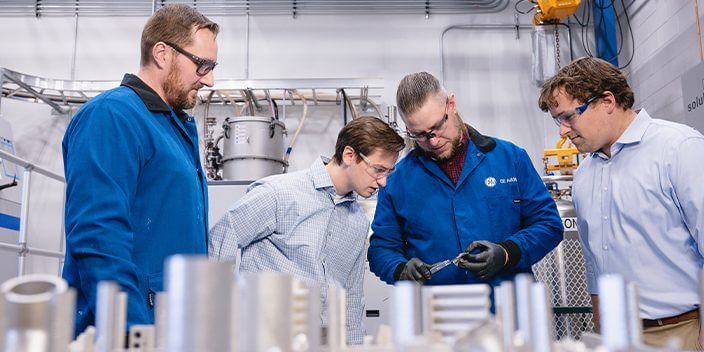Scramjet prototype tests Purdue hypersonics additive-manufacturing capabilities

WEST LAFAYETTE, Ind. — A team at the Purdue Applied Research Institute (PARI), the university’s research and development center, is using state-of-the-art additive-manufacturing equipment to print a full-scale, fully operational prototype of a supersonic combustion ramjet, or scramjet, an engine that allows aircraft to travel at speeds of Mach 5 and beyond.
Researchers in PARI’s Hypersonic Advanced Manufacturing Technology Center (HAMTC) believe this innovative scramjet design paves the way for more affordable and expedient prototyping and manufacturing processes across the hypersonics industry.
“There’s no other university-affiliated institution with the capability to manufacture and then test hypersonic technologies at flight-relevant scales and conditions,” said graduate research assistant Will DeVerter, who created the full-scale scramjet prototype with senior test engineer Nick Strahan. “Once we have a part or system ready to go, I can walk it across the street and test it using some of the best propulsion and diagnostic technology in the world. That’s a unique capability that streamlines the entire manufacturing and testing process.”
Strahan likened scramjet functionality to trying to light a candle in a hurricane. “You have to sustain a flame in air speeds in excess of Mach 2, so the technological challenge is creating a combustor that can operate efficiently and burn fuel with air traveling at really high velocities,” Strahan said.
Mark Lewis, president and CEO of PARI, said that scramjets are still in their infancy “but are generally regarded as the best way to power a missile or aircraft through the atmosphere at speeds above five times the speed of sound, in the so-called hypersonic realm.” Scramjets are “very simple in principle,” Lewis said, “but extremely complex in actual design,” which is why using additive manufacturing has been such a breakthrough.
Printing and testing a scramjet can be expensive and time-consuming. Most applied research labs with additive manufacturing capabilities can only print small, scaled-down versions for testing. These models are then extrapolated to create full-size scramjets, whose parts must be printed individually and then assembled. However, using the enhanced manufacturing technology available at PARI, researchers can print full-scale, fully operational production models.
The additive manufacturing center is in PARI’s Hypersonics and Applied Research Facility and provides a one-stop shop for manufacturing innovations that can be transitioned to the defense market. Michael Sangid, HAMTC’s executive director and the Reilly Professor of Aeronautics and Astronautics Engineering, said the full-scale scramjet prototype showcases the center’s potential to revolutionize the hypersonics industry.
“The scramjet pilot project is a great example of our vertically integrated capabilities,” Sangid said. “We can take raw powder and turn it into representative test data from a fielded prototype in a few short months. This leverages the flexibility of additive manufacturing into the component’s design to increase efficiency.”
Key to the prototype are weight and part reduction without compromising the functionality and geometric complexity necessary for the engine to work. This effort is accomplished with the GE Concept Laser X Line 2000R, a printer used for large-scale metal manufacturing. The X Line 2000R employs a process called laser-powder bed fusion, where the laser in the printer melts and fuses together particles to form a solid part. Because of this capability and the printer’s large capacity, fewer parts are required to build the engine; that allows for rapid prototyping with increased design complexity and simplified assembly.
This prototype not only uses PARI’s machinery but also serves as a test bed for experiments and new technologies. The additive manufacturing center is adjacent to Purdue University’s Maurice J. Zucrow Laboratories, among the largest academic propulsion labs in the world. This project integrates PARI’s manufacturing capabilities with Zucrow’s high-speed propulsion test facilities, which can simulate conditions at Mach 5 and higher, as well as provide laser-based diagnostics of materials at high speeds.
A faster, more efficient process ultimately cuts costs and helps to meet the nation’s demand for more advanced hypersonic technologies. Senior project manager David Bretz coordinates all aspects of this project and sees its potential impact on national security and the defense industry.
“Because of the faster and less expensive scramjet design, we’ll be able to more easily prototype it, test it and then go back and iterate the design, which will contribute to the nation’s hypersonics knowledge base and increased capabilities,” Bretz said. “Also, students are involved throughout all aspects of the project, from the design to the manufacturing process to testing. Purdue students from undergraduates to the graduate level are learning the skills needed to work in the hypersonics industry.”
Carson Slabaugh, the Paula Feuer Associate Professor of Aeronautics and Astronautics, and Sangid are the faculty leads on this project. The scramjet effort is one of five projects funded by the Office of the Secretary of Defense Manufacturing Science and Technology Program, partnering with the Naval Surface Warfare Center, Crane Division, and the National Security Technology Accelerator’s Strategic and Spectrum Missions Advanced Resilient Trusted Systems.
About Purdue University
Purdue University is a public research institution demonstrating excellence at scale. Ranked among top 10 public universities and with two colleges in the top four in the United States, Purdue discovers and disseminates knowledge with a quality and at a scale second to none. More than 105,000 students study at Purdue across modalities and locations, including nearly 50,000 in person on the West Lafayette campus. Committed to affordability and accessibility, Purdue’s main campus has frozen tuition 13 years in a row. See how Purdue never stops in the persistent pursuit of the next giant leap — including its first comprehensive urban campus in Indianapolis, the new Mitchell E. Daniels, Jr. School of Business, and Purdue Computes — at https://www.purdue.edu/president/strategic-initiatives.
Writer: Lindsey Macdonald macdonl@purdue.edu
Media contact: Evamarie Socha ecsocha@purdue.edu
Sources:
Source: David Bretz dbretz@purdue.edu